-
“We are enjoying the cool air from our new HVACs, which Air Plus flawlessly installed.
” - Bradley H.

What Is an HVAC System?
HVAC is an acronym for “heating, ventilation, and air conditioning.” It refers to the various systems and mechanical components that regulate environmental conditions in a home, office building, and transportation systems to provide greater comfort. There are several components in HVAC systems that work congruently to regulate environmental conditions; knowing each term and how they work will help you save time and money when performing maintenance or repairs.
The various components of most traditional HVAC systems include:
- Thermostat: The thermostat is perhaps the most familiar part of any HVAC system. It is usually attached to a wall in the main area of a building and can be programmed or manually set to the desired temperature. Inside, there is a small thermometer that measures the air temperature and triggers either the heat exchanger or the evaporator coil-condenser into action. Technology has advanced thermostat controls with a growing variety of smart thermostats promising better efficiency, remote control, and a host of other smart home control options.
- Furnace: A furnace is usually quite large and can often be found in basements or large cabinets within a home. A furnace works by burning a fuel source, such as natural gas or electricity, to heat air that passes through it, often propelled by a fan.
- Heat Exchanger: This is one of the most important components of an HVAC system, and it must stay clean to prevent fire hazards and maintain peak efficiency. It consists of a sheet of steel that transfers heat into the air.
- Evaporator Coil: The evaporator coil is an HVAC component that resembles the letter "A.” It works to cool the air passing through it.
- Condensing Unit: The condensing unit can be found outside. It houses a refrigerant gas and works with both the evaporator coil and heat exchanger.
- Refrigerant Lines: Refrigerant lines consist of copper or aluminum coils that transport the refrigerant gas to the condensing unit.
- Ducts: Ducts and ductwork can be made of various materials. They form a network throughout the home (or building/vehicle) and work as a means of transporting the air to the desired destination. Ducts can be configured to provide heating and cooling zones that work off separate thermostats to better ventilate different areas of your home. Meanwhile, if your home or commercial space does not have ductwork, we can assist you in finding a ductless mini-split system that meets your heating and cooling needs.
- Vents: These are the final destination for the air to be released into the building or vehicle.
Are you wondering about the best type of HVAC system for your home or business? Contact us today to speak with one of our expert HVAC technicians to discuss your needs and questions!

Up to $4300 in additional savings! *Conditions apply. See www.lennox.com/terms-and-conditions for complete terms and conditions. Valid from Mar 1, 2023 - Jun 30, 2024
How to Choose a New HVAC System
Purchasing a new HVAC system can be confusing. What's important to consider? Is the most energy-efficient system worth the money? If you sell your house, will you get your purchase value out of the sale price? How much should you really spend on a new HVAC system to be sure you’re getting the best system to meet your needs?
At AirPlus, we think our customers deserve answers to these and any other questions they have. With that in mind, we’ve put together a helpful guide to choosing the right HVAC system for your home or commercial property.
Here are some things you may want to consider:
- Higher SEER Costs More but Saves on Energy Bills: SEER rating refers to the overall energy efficiency and performance of a given HVAC system. With higher SEER-rated systems, the upfront investment on equipment will also be higher but, in most cases, the added investment will save you money in the long-run by reducing your energy bills. Plus, high-efficiency furnaces and other system equipment can offer additional features not often available on less-efficient, inexpensive HVAC systems.
- How Long You Plan to Stay in Your Home: If you plan to stay in your home for less than five years, investing in a high SEER-rated HVAC system may not make sense, as you may not experience the savings earned in the long-run by reducing your energy bills. In this case, an efficiency upgrade may not make sense. If you currently have a 14 SEER or 16 SEER system, and you do not plan to stay in your home for more than five years, you should consider replacing your system with one that has the same efficiency rating. If, however, you plan to stay in your home for five years or more, you might consider investing in a system with high efficiency, like an 18 SEER or 20+ SEER HVAC System with a modern, 90+ percent efficient furnace.
- How Much You Are Willing to Spend, Now and on Future Energy Bills: At AirPlus, we recognize that cost is one of the most important factors for home and business owners looking to replace their existing HVAC systems. It’s important to consider both upfront and future energy costs, but we also know that the initial expense can sometimes be prohibitive when it comes to upgrading your system. With that in mind, we offer a variety of specials, discounts, rebates, and coupons to our customers. We also offer financing to qualifying customers on all HVAC (as well as plumbing and electrical) projects. Your new HVAC system cost could be as low as just $86 per month, with furnace replacement costs as low as $30.03 per month and air conditioner and coil replacement as low as $46.08 per month!
If you would like more information, simply give us a call and talk with one of our expert HVAC consultants to learn more about our packages and other available options. Looking to replace just parts of your HVAC system? We can help with that, too! Reach out to us today to learn more.
Services We Offer
As a full-service home comfort company, we offer a complete range of heating, ventilation, and air conditioning services, including:
- Installations: Are you in need of new cooling equipment for your home? Our experts will be happy to help you every step of the way, from picking a brand and model to inspecting your space to determine what size equipment will work best. From full HVAC systems with central heating and air conditioning to boilers, heat pumps, furnaces, and water heaters, we are familiar with all the latest models and can assist you in making comparisons. This enables you to quickly see the total cost of ownership, maintenance, and service requirements, as well as the relative energy efficiency of different models. When there are potential rebates from manufacturers or the government for using environmentally friendly HVAC equipment, our team will make it easier for you to make a fully informed decision.
- Replacements: Perhaps your HVAC system is so old that it is on the verge of malfunctioning or even falling apart. Each situation is going to be different, which is why you will want our expertly trained professionals to evaluate your HVAC system. If repairs would cost more than replacement, we will advise you on your next steps. Even if repairs will be somewhat less expensive than replacement, you must consider that older equipment is typically inefficient by today’s standards. Replacing older, outdated HVAC equipment with modern, environmentally friendlier equipment means you will enjoy the same level of comfort in summer and winter while seeing your utility bills drop.
- Repairs: If your HVAC equipment doesn’t seem to be working properly—for example, if it’s making strange noises or never seems to provide consistent heating or cooling—you’ll want to arrange for repairs as soon as possible. Catching minor issues now means that your repair bill will likely be much lower than if you waited for the HVAC system to grind to a halt.
- Maintenance: Your heating and air conditioning equipment requires regular cleaning, inspections, and maintenance. AirPlus strives to keep your heating and air conditioning equipment running in tip-top condition so you will get the best value for your HVAC investment all year round. If you don’t arrange for yearly maintenance, small problems will only grow worse, leading to much more expensive service fees for major repairs or outright replacement.
Our HVAC Brands
At AirPlus, our professionals provide service on a wide range of equipment from brands including:
- Amana
- American Standard
- Armstrong
- Aerosys
- Bryant
- Carrier
- Comfort Maker
- Daikin
- Ducane
- First Company
- Fujitsu
- Heil
- Lennox
- Goodman
- Mitsubishi
- Payne
- Rheem
- Ruud
- Trane (We are a Trane Comfort Specialist)
This list is just a sampling. If you don’t see a brand in this list, contact our team and we can surely help you.
Our Commitment to You
As a family-owned business that’s been providing high-quality heating and air conditioning services in Northern Virginia since 2005, we take pride in the fact that thousands of satisfied customers have come to rely on us for all their HVAC needs. That’s one reason why we get so much repeat and referral business.
We are committed to providing you with the highest quality workmanship and proudly stand behind everything we do. We also want to provide reliable HVAC installations, replacements, maintenance, and repair without breaking the bank, which is why we offer low everyday rates and honest, upfront pricing. We even provide free estimates for most HVAC services, including new system installations and repairs.
Book your service online or call us at (571) 470-7235 today to speak to a member of our team. We are available 24 hours a day, 7 days a week.

Contact Airplus Today
Servicing All BrandsOur team is here to answer your questions. Contact us today at (571) 470-7235 or complete the form below.
.2309121422550.png)


